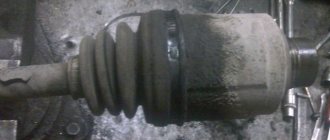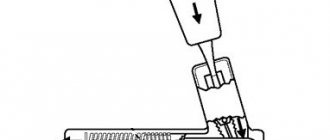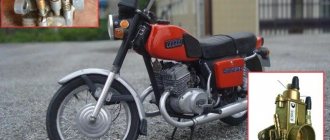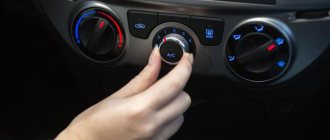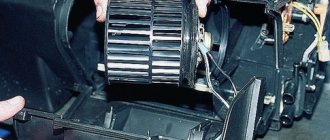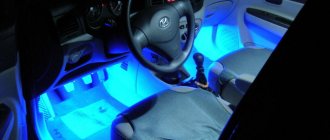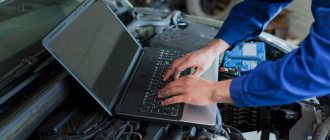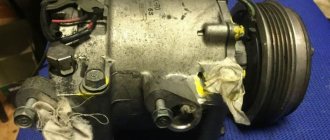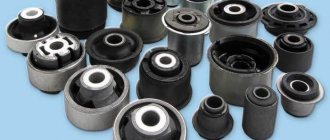There is vibration during acceleration: the main causes of the problem
There can be a huge number of possible problems with a car, and a specific breakdown does not always give specific signs of its presence. Drivers often complain about body shaking when accelerating or at a certain speed. There can be quite a lot of problems that determine this indicator. If your car has vibration during acceleration, you should look at all possible breakdowns and immediately replace the failed components.
It is not always possible to tell by the nature of the vibration where exactly the problem lies. On different cars, only the steering column can vibrate, putting it in the driver’s hands, but the entire body can shake. It all depends on the design, nature and degree of damage to the components and assemblies that need to be replaced. Let's look at the main causes of vibration during overclocking.
Causes
Vibration in the body during acceleration occurs due to an imbalance in the chassis of the car, for several reasons:
- The structural reason is due to the design of the part that disrupts the balancing, for example, a tire inflation valve affects the balancing of the wheel (may disrupt it);
- Technological reason, here the vibration is caused by a deviation from the dimensions and parameters of the elements that are being replaced;
For example, the mass of the repair connecting rod may deviate from the normal value, which causes uneven load distribution in the engine and, as a result, vibration during acceleration, while driving, and even vibration in the body at idle.
- Operational reason, vibration occurs when a part is unevenly worn, deformed, or perhaps due to the loss of properties (destruction) of vibration isolators.
Vibration isolators are motor mounting pads, boxes and others. They reduce shocks that are transmitted from the engine to the frame and body of the car. These supports (pillows) are usually made of a pair of metal elements that are separated by a layer of rubber. Body vibration during acceleration and at idle may occur due to their destruction. Occurs when the rubber material is worn out or the manufacturing technology is violated. If during acceleration the vibration of the body is caused by the cushions, they should be replaced immediately
If the engine vibrates constantly, then the most effective way is to balance the parts. Of course, it will be difficult to eliminate vibrations that originate from the engine 100%, but it is possible to significantly reduce the vibration level to a minimum.
Engine parts to be balanced
When performing the balancing procedure, the part is subjected to diagnostics. Using a special device, its heaviest side is determined. Then the master decides whether to lighten the heavy part or make the opposite side heavier. This option is used when balancing wheel rims. It is important to note that it is almost impossible to independently determine the light and heavy sides of the wheel, and the crankshaft, especially without equipment and experience.
We study wheels and chassis - the main cause of vibrations
The main indicator that the wheels or drives of these same wheels are to blame for your problems is shaking at a certain speed. Often these are body vibrations in the range of 80-100 kilometers per hour, but sometimes the shaking may not go away even after 60 km/h, so in any case you need to fully diagnose the chassis.
In this case, it is not necessary to go to a service station and carry out expensive diagnostic operations. It is enough to apply all your knowledge and study each chassis unit for possible breakdown. The most common problems in this case are the following:
- the wheel mounts are unscrewed, which causes vibration on one of the wheels;
- The brake disc is poorly fixed; at speed it begins to vibrate;
- the wheel drive shaft is bent - the body vibrates constantly, the vibration intensifies when accelerating;
- damaged CV joints - this is the most common problem that causes vibrations on the body;
- The wheel bearings are damaged, which causes shaking at any speed.
The most common problem in this manifestation is CV joints. To check their serviceability, just grab the shaft with your hand and try to turn it. If the shaft has play of more than a couple of millimeters, the CV joint must be replaced. Interestingly, body vibrations during vehicle acceleration can be caused by both external and internal CV joints.
You can also easily determine if there is a problem with this chassis mechanism by examining the anthers. If the rubber part of the boot ruptures, we can safely talk about problems with this mechanism. If water, dust and dirt get into the CV joint, the unit will not survive more than a few days.
Why vibration on VAZ 2107
Good evening, teammates! The chassis completely tormented me after the repair! Start over. In general, my clutch has “come to an end” and I gave my 2107 to a mechanic to replace the clutch and inspect the car before winter. I changed the disk and basket to Kraftek. During the replacement process, the master installed crosspieces, an elastic coupling, an outboard bearing, and a shank seal. Previously listed items were purchased and exchanged. And after that it began... They gave me the car and my joy ended at 40 km/h. At approximately 35-40 km/h a strong and soft vibration appears, this is especially felt if you touch the passenger seat from behind. This vibration is only in 40, and in 2nd, 3rd and 4th gears the same way. We drive it back for repairs, we are sinning on the crosspieces , I buy a set of new crosspieces 2 times and change them. And nothing happens. Again the same vibration at the same speed. After that, the cardan was turned over more than once, the cardan bolts and nuts were replaced again, the limit switch was released, and nothing changed. It felt like after the limit switch was released, it began to howl like a gearbox and vibration began even at 60 km/h. According to the master, before removing the cardan, he made marks and installed everything back according to the marks. The discs are watermelon-mounted, with a 5mm spacer added to the front on each side. C.o. does not match on the wheels 61.0 and on the hub 58.6. The new tires have only driven 1500 km, the wheels have been rolled. Balancing is normal.
Wheel alignment and tire quality are another reason for shaking
If the wheel alignment angle is incorrect, vibration, the car pulling to the side, uneven eating of rubber and other unpleasant manifestations are possible. In different models, these problems manifest themselves in different aspects. Adjusting the wheel alignment angles is one of the first processes that needs to be performed after detecting such a nuisance as body vibration.
Problems can also be caused by tires that are worn incorrectly, or a disc after a serious impact. The main processes that can be taken to eliminate body vibration in this case are as follows:
- adjusting the wheel alignment angle at a wheel alignment station;
- replacing tires if there are visual indicators of uneven or excessive wear;
- replacing or repairing a disc that shows dents and uneven rims;
- performing wheel balancing - often during operation the balancing weights fly off.
If the balancing weights have come off the wheel, this may well cause vibrations at speeds of 80 kilometers per hour. The problem is that it is simply impossible to determine this yourself and find out which wheel needs to be sent for balancing. Therefore, you will have to go to a tire shop and have all the wheels of your car balanced.
This is one of the most inexpensive and safest options for breakdowns due to vibration of the body or steering wheel during acceleration. Therefore, the first thing you need to do is check for the presence of such faults, and then transfer suspicions to other options.
Reason one: wheels
When you feel shaking, don’t immediately assume the worst. In most cases, stingrays are to blame. Sometimes even a visual inspection is enough to make sure of this.
The camber and toe are broken. Moreover, depending on the magnitude of the incorrect angle, it can shake only during acceleration or in a certain speed range. Purely outwardly incorrect camber/alignment quickly manifests itself as uneven tire wear. If the inner or outer side of the tire is more worn, you are dealing with exactly this situation. The adjustment will immediately eliminate the runout.
This point is directly related to the previous one. You corrected the angle, but left the old tires - it drives the way it is used to. You need to either change the wheels, or drive slowly and carefully for a while until the wear becomes even over the entire surface.
The impact of the disk and disruption of its geometry can also cause vibration, and at non-city speeds. Dents and potholes can be detected even with a superficial inspection. Editing or replacing the disk will correct the situation.
Another common cause of shaking is the loss of balancing weights. Getting an unscheduled wheel balancing will get rid of vibration.
It would also be a good idea to check the wheel fastenings: a lost bolt also causes serious beating.
Engine mounts, tie rods and other problems
There is another group of problems that cause vibrations when accelerating a car. It is difficult to collect these problems into one bundle, because they are all different and arise for various reasons. Vibration often occurs when one of the engine mounts is broken. This can easily be checked by increasing the speed while shaking.
The gearbox may also be the culprit for this type of problem. If the car starts to shake at 80 kilometers per hour, you can very easily check the fault of the gearbox by performing the following procedures:
- accelerate to a speed of about 85 kilometers per hour;
- depress the clutch and observe the vibration change;
- engage third gear and smoothly release the clutch;
- try accelerating from 50-55 kilometers per hour in last gear.
If the nature of the shaking does not change in all these experiments, the box has nothing to do with this problem. If there is more shaking when the gearbox is engaged, you will have to check whether it is involved in this problem.
You can also check the automatic transmission. At a speed of about 85-90 kilometers per hour, it is enough to switch the gearbox selector to modes 3, 2, D, N and observe the operation of the box itself and the change in vibrations. Often the gearbox is not to blame for the vibration of the car body, but there are such cases.
For useful tips on some possible causes of shaking, watch the video:
The main misconception about body vibration
Gas reducer
Many people are mistaken that the cause of body vibration is a malfunction of the gearbox, so some even decide to replace it.
But it's not right. The only exception is if the gearbox flange nut has become loose, so there is additional play.
With such play, the gearbox flange swings up or down. Such play must be eliminated in any case, since it indicates a malfunction. After all, ideally there should be no swaying.
Such play can cause vibration of the car body. In fact, vibrations in the body can lead to loosening of the flange. If there is no such play in the gearbox, then it cannot be the cause of vibration in the body. Therefore, if some technician says that vibration will be eliminated after repairing or replacing the gearbox, then you should not trust him.
Let's sum it up
If you are unable to find the problem that is causing the body or steering wheel to vibrate in your car when accelerating, you should contact a professional. Do not leave this problem, because it can worsen and create dangerous travel conditions for the driver and passengers of the car. It is necessary to respond as quickly as possible to all possible problems and eliminate them by replacing failed machine elements.
Often, to determine the problem, you don’t even have to go to a service station and use expensive diagnostics. It is enough to inspect the car yourself and determine what problems caused the body vibrations. Have you had similar problems in your experience, and what parts of the machine caused them?
Let's sum it up
So, common causes include wheel mounts, loose brake discs, a deformed drive shaft, constant velocity joints, and wheel bearings.
Vibration occurs when accelerating from anything. There are a lot of reasons. But if you try, you can detect them yourself and not pay for diagnostic services at a service station. But if suddenly you can’t figure it out on your own, don’t put off the decision. This leads to bad consequences. With simple steps, you will definitely find the causes of vibrations in your car and eliminate them. Take malfunctions seriously, because a neglected problem can cause an accident.
Dmitry0585 › Blog › Vibration during acceleration. Inner CV joint
It seems to be known that vibration during acceleration is often a sign of a malfunction of drives, namely internal CV joints, but few people manage to diagnose it quickly. That's why I decided to write so much. There are a lot of symptoms and you can go through the whole car, but still not solve the problem.
If you are too lazy to read, look at the end of the post, there is a list of symptoms and a solution to the puzzle.
For 7 years of owning an Octavia A5 1.6 BSE automatic transmission, there were no problems and I didn’t write anything about my car on the Internet. The car is great. But in the eighth year a vibration appeared. And I want to share my experience to help those who are puzzled with solving this problem.
So. Shortly before the vibration appeared, I bought new tires and did a front wheel alignment. At the back they said you don’t have to do it because... deviations are minimal. I first noticed the vibration at a speed of 110 km/h. When you press the gas at a given speed, there was a slight shudder throughout the body, you release the pedal, it immediately disappears. Unpleasant but not critical. Well, it’s clear that you need to look at the wheels. I balanced it 3 times, it didn't help. We hung the car on a lift and accelerated it, the receiver also felt the vibration. I stood with the serviceman under the car and he showed how the left wheel jumps and the right one jumps a little. He said it was bad tires. They said that they needed to put on another set of wheels and look, but they wouldn’t find anything. It's rubber for sure. I called the official dealer and they said “miracles don’t happen, it’s the wheels.” I went to another service center for suspension diagnostics. Everything is fine. I gave up temporarily on the problem. A month later I did a major maintenance. And I also changed the brake discs and pads all around. Well, I think it might help. No, it didn't help. I chose a quiet, new, smooth road and began to ride along it at low speed. Damn, the vibration at a speed of 20-25 km/h is extremely unpleasant, the car rocks to the sides, as if the wheels are completely crooked. If you press harder on the gas, the oscillation frequency is higher but the amplitude is smaller and less noticeable. And then I understand that driving around the city in a car for a couple of months is not very comfortable; when starting from a traffic light, it chatters (I thought the asphalt was floating everywhere); when braking, it is also somehow uncomfortable. Well, since they don’t find anything, I don’t intend to go through the whole car. The fault will come out more clearly, so I’ll fix it. For the sake of experiment, I installed a winter set of wheels on other rims, but it didn’t help, so it’s not the tires. I drove like this for almost a year, until it really started to infuriate me and I started to get tired of this topic again because... it got worse. The shaking became noticeable and increased in the interval from 40 to 60, and if you go uphill, it’s generally rough, chattering in front as if you were riding on some kind of rattletrap. I’m going to the service center, we’re driving with the receptionist, he doesn’t feel the vibration, and we’re driving on a shitty road. He says they won't find anything. I read a lot of posts on the Internet and became more and more convinced that this is an internal CV joint. When the car was 2 years old, the boot of the inner left CV joint broke, and that probably ruined it. I'm going to the service center to check its condition. We remove the shaft, disassemble the inner CV joint, and wash it. There is no noticeable wear on the glass. But the tripod itself is a little loose. The serviceman says that the tripod is Khan, I look at the tripod and don’t believe him. But I'm not an expert. There are no signs of illness on the tripod except for small play. Looks decent. After some hard thinking and reading the Internet, I decide to buy an original CV joint. The price is painful, but I didn’t want to install a non-original because there are all sorts of situations with them and it doesn’t seem to last for a long time. I bought an original CV joint and went to change it. Changed, I'm leaving. Nevermind. Everything is as it was. I was upset, but I was ready for it. I don’t know what to do anymore, I’ve lost my mind. I turn off the music and even the climate control so that there is silence. I’m driving around the yard and I hear how, in second gear, when I release the gas and then press it, I hear a small knock, similar to a click, as if the gears are engaging. God forbid it’s also a box...
Vibration in a car - common causes
A serviceable car should move smoothly, no matter what speed is marked on the speedometer. However, when the machine is used for too long, vibration problems may occur. This is a very unpleasant situation, which, as a rule, begins gradually, and one day develops into a global one. Do not underestimate such a defect, since a working vehicle should not experience noise, vibration or other phenomena.
Any problem that is associated with the wear of elements in the vehicle begins to progress over time. For example, for a couple of weeks it may be a slight shaking of the body, but in a month the sound and vibration will be so strong that the car will fall apart while driving. Don't wait too long, as expensive repairs may be required. Diagnosis and detection of the cause of the defect is already half the battle. If the car starts to shake and shows its considerable age, you can pay attention to the 5 most common “culprits”.
Problems with wheels . Tires are the most common cause of vibrations during acceleration. Typically this is due to improper balancing. At slow speeds the defect will not be noticeable, but after 60 km/h the body will begin to shake. The steering wheel and seats may vibrate. In addition, this phenomenon can occur if the owner has not inflated the tires correctly. Too high pressure will create conditions under which the car will feel all the bumps on the road. This problem is solved very quickly. You just need to set the pressure indicators specified by the manufacturer. Vibration often occurs in situations where tires wear unevenly. It is necessary to periodically inspect the tread. If wear is noticeable on one part, you can rotate or swap the wheels. If possible, purchase new tires and get a wheel alignment done after installation.
Usually vibrations arising from defective wheels go to the steering wheel. The most common culprit is a worn wheel bearing. Of course, these elements are claimed to have a long service life. But like any other mechanism, it can fail ahead of time. Another thing to check is the rod ends or ball joints. If the steering wheel behaves normally when driving in a straight line, but vibrates when turning, this indicates worn ends of the rod. If the opposite situation is observed, when the steering wheel moves on a straight line, but when turning it behaves as usual, you can think about a malfunction of the ball joint.
Motor . When the engine in a car does not receive enough air, fuel or sparks, you may notice vibrations coming from the engine compartment as you accelerate. In this case, the trembling is accompanied by jerking, shaking and abnormal operation of the motor. To fix such problems, you need to check the condition of the elements in the engine. The first step is to inspect the spark plugs and install a new set. Then check the fuel and air filters - they may become clogged.
Brakes . If vibration occurs when you press the brake pedal, the brake rotor is faulty. This element must be checked and replaced if necessary. Another reason is the wear of the brake caliper pin. The steering wheel, at the same time, produces vibration already at a speed of 50 km/h. As the indicator increases, the manifestation of the defect also increases. Note that problems that arise in the braking system must be addressed immediately, since this is one of the most important components in the car, which is responsible for safety.
Axle problems . If the vehicle has recently been in an accident, it is likely that the axle has become slightly warped. If vibration occurs while driving, you need to check the driveshaft - it transmits power to the axles. If the car seems to bounce and the phenomenon is accompanied by vibration and noise, this may indicate a broken constant speed joint. To solve the problem, you need to repair or replace.
Bottom line . Vibration in a car can have several causes. It is necessary to carry out diagnostics in time, as sometimes this can indicate a breakdown in the brake system.
Why did vibration appear when accelerating?
Good day to the readers of my blog! This is Andrey Kulpanov, and I am ready to discuss another problem with you. Many drivers may encounter it, and therefore you should prepare in advance: be able to recognize the symptoms, as well as understand the consequences and how to avoid them. Now it’s time to introduce the problem itself - vibration when accelerating.
Of course, there is the concept of a certain standard vibration and its magnitude, which are allowed by the manufacturer. However, we will talk about malfunctions in which acceleration brings discomfort to everyone inside the vehicle. Let's look at why this phenomenon occurs.
Suspension and driveshaft
Runout is often caused by faulty steering and/or suspension. Vibration, at the same time, is accompanied by creaks and knocks when performing maneuvers, as well as uncertain behavior of the machine itself. The fault may be worn rubber elements, hinges, tips, struts, bearings. In short, there are many reasons to visit a service station.
Another culprit for cars with all-wheel drive or rear-wheel drive may be the driveshaft. Why does vibration occur in this case? Due to wear of the universal joint. If the cardan is not balanced enough, it causes not only runout, but subsequent destruction of the joint areas. You also need to pay attention to the condition of the outboard bearing and crosspieces when inspecting this unit.
How tires and balancing affect
One of the possible causes of runout is unbalanced wheels. This occurs due to the fact that centrifugal forces arise, because the mass is distributed unevenly relative to the center of the car wheel. This phenomenon often appears when changing tires with the advent of other climatic conditions or purchasing a new set of car tires. All you have to do is go to a tire shop, where the technician will be able to perform ideal weight distribution, and vibration will be eliminated.
Further, the reasons may be due to the fact that the old balancing weights are lost. The wheel may fall into a deep pothole or the weights may be lost due to hitting a hard road obstacle. Or imbalance may occur naturally during operation. That is why it is recommended to balance the wheels after 15–20 thousand kilometers traveled.
Tires of dubious quality are another reason why the car suddenly began to vibrate. During measurements on a special stand, the smallest deformations may not be detected, but they will manifest themselves in the future. In this case, the problem will be solved only after replacing the tires.
Drivers whose car is equipped with low-profile tires may face the same situation. The fact is that the side cord of such rubber cannot boast the same degree of elasticity as that of traditional tires. Microdeformation inevitably occurs, especially if the car had to stand in one place for a long time. However, the vibration does not last long - just carefully pick up speed until the rubber warms up. Excessive tread wear leads to the appearance of hernias and bumps, and this will cause additional vibration loads.
Engine mounting as one of the causes of vibration
As you know, the engine is mounted on supports, also called cushions. These are a kind of brackets, which in one part are attached to the car body, and the second part is made of hard rubber and one of the points of the power unit is already attached to it. Namely, the rubber base of the supports dampens the natural vibration of the engine that occurs during its operation. And in the event that the engine mounts are worn out or damaged and engine vibration occurs in a VAZ car. In this case, it is necessary to replace damaged supports.
Engine vibration can occur during certain malfunctions in the ignition system, in which sparking at the spark plug electrodes is disrupted. Misfire, spark plug failure, damage to the high-voltage wire, distributor malfunction, incorrectly adjusted ignition leads to the engine starting to misfire and, as a result, vibration occurs. Eliminating all of the above reasons will help restore stable operation of the power unit.
Engine vibration after a major overhaul
If, after assembling the engine after its repair, vibration is felt in all modes, then there may be a number of reasons. Firstly, the crankshaft is not balanced. During assembly, before installation, the crankshaft must be balanced on a special stand. The engine flywheel also needs to be balanced. Secondly, incorrectly set gas distribution mechanism marks lead to disruption of gas exchange phases during engine operation.
Engine and other reasons
What else could cause your car (I had this on a Ford Focus) suddenly to cause discomfort during acceleration? If the vibration is also accompanied by a hum, this may indicate a wheel bearing failure. You should not delay repairs, because the bearing can simply fly apart when moving, and this will have more serious consequences. This is evidenced by wheel play - if this is detected, then it needs to be changed as soon as possible.
And, finally, an internal combustion engine can also be a provocateur of vibration processes. For example, the motor begins to stall, which is always accompanied by rattling and unstable operation. This problem can be complex:
- malfunction of one of the spark plugs;
- poor quality fuel;
- burnout of any of the valves.
The power unit cushions deserve special attention. The fact is that an increase in engine speed leads to an increase in centrifugal forces acting on the car body. When the airbags become loose, even pressing the gas pedal sharply is enough to cause noticeable shocks. Replacing old pillows with new, harder ones can lead to the same phenomenon.
But still, the main possible reason is the following (watch the video).
As you can see, dear motorists, there are more than enough reasons why vibrations may occur when driving. In all situations, you need to understand the problem in more detail, since the problem may be not only in the engine, but also in the suspension, steering, and tires. An experienced auto mechanic can help you determine what caused the problem. Let's close today's topic and say goodbye. Bye!
Why did vibration appear when accelerating?
Good day to the readers of my blog! This is Andrey Kulpanov, and I am ready to discuss another problem with you. Many drivers may encounter it, and therefore you should prepare in advance: be able to recognize the symptoms, as well as understand the consequences and how to avoid them. Now it’s time to introduce the problem itself - vibration when accelerating.
Of course, there is the concept of a certain standard vibration and its magnitude, which are allowed by the manufacturer. However, we will talk about malfunctions in which acceleration brings discomfort to everyone inside the vehicle. Let's look at why this phenomenon occurs.
Suspension and driveshaft
Runout is often caused by faulty steering and/or suspension. Vibration, at the same time, is accompanied by creaks and knocks when performing maneuvers, as well as uncertain behavior of the machine itself. The fault may be worn rubber elements, hinges, tips, struts, bearings. In short, there are many reasons to visit a service station.
Another culprit for cars with all-wheel drive or rear-wheel drive may be the driveshaft. Why does vibration occur in this case? Due to wear of the universal joint. If the cardan is not balanced enough, it causes not only runout, but subsequent destruction of the joint areas. You also need to pay attention to the condition of the outboard bearing and crosspieces when inspecting this unit.
How tires and balancing affect
One of the possible causes of runout is unbalanced wheels. This occurs due to the fact that centrifugal forces arise, because the mass is distributed unevenly relative to the center of the car wheel. This phenomenon often appears when changing tires with the advent of other climatic conditions or purchasing a new set of car tires. All you have to do is go to a tire shop, where the technician will be able to perform ideal weight distribution, and vibration will be eliminated.
Further, the reasons may be due to the fact that the old balancing weights are lost. The wheel may fall into a deep pothole or the weights may be lost due to hitting a hard road obstacle. Or imbalance may occur naturally during operation. That is why it is recommended to balance the wheels after 15–20 thousand kilometers traveled.
Tires of dubious quality are another reason why the car suddenly began to vibrate. During measurements on a special stand, the smallest deformations may not be detected, but they will manifest themselves in the future. In this case, the problem will be solved only after replacing the tires.
Drivers whose car is equipped with low-profile tires may face the same situation. The fact is that the side cord of such rubber cannot boast the same degree of elasticity as that of traditional tires. Microdeformation inevitably occurs, especially if the car had to stand in one place for a long time. However, the vibration does not last long - just carefully pick up speed until the rubber warms up. Excessive tread wear leads to the appearance of hernias and bumps, and this will cause additional vibration loads.
Body vibrations
Vibrations usually occur when driving at high speeds. As a rule, if the car is moving at speeds up to 80 km/h, then no vibrations will be observed. But as soon as it exceeds this limit, vibration in the body at speed will appear immediately.
During idle
The most common case of body vibration at idle is improper operation of the engine cylinders. Often they begin to work unevenly, which can lead to various consequences.
If one of the cylinders fails, the engine shakes when idling. As the speed increases, the shaking usually becomes less noticeable, but continuing to drive at high speeds is not recommended. After all, a broken cylinder still contains a certain amount of fuel, which can damage the exhaust gas catalyst. And this can lead to the engine simply stalling.
In addition, you need to take into account that not only those engines that have any damage can vibrate. However, during normal operation, this shaking should not transfer to the body. To prevent this from happening, not a single part of the engine should come into contact with parts of the body. Therefore, it is advisable to use different shock absorbers or pads.
While driving
The main reason why vibrations occur in the body at high speeds is poor-quality engine mounting.
Quite often, the mechanics who install the motor do not pay attention to the suspension, so they mount the engines at random. And this subsequently leads to vibration appearing in the car interior.
Fixing this problem usually doesn't take long. All you have to do is disassemble the suspension, loosen the engine mounts, and then re-tighten the suspension. After this, the problem of excessive vibration will disappear. But this is only if there is no serious damage to the body. Otherwise, it will not be possible to completely get rid of noise.
Engine Mount Diagnostics
You can diagnose the engine mount by following this simple algorithm:
- If the car is equipped with an automatic transmission, then you must first warm up the engine, and then place the shift lever in the neutral position;
- Engage reverse gear and press the gas to achieve the same speed that was achieved in the neutral position of the car;
- After this, you need to pay attention to the degree of vibration: has it become more or less;
- Go to position D and do the same;
- Now the check will be carried out in position R. It is necessary to press the brake, and then the gas. You need to quickly release the pedal. In this case, the car hood must be open;
- The same manipulations must be performed in position D;
- If any engine support is destroyed, the engine will deviate to one side, and when the gas is released, it will sharply return to its original position.
Other reasons
Cardan shaft
- Most often, vibrations occur due to improper operation of the driveshaft. By the way, its imbalance can also cause such a problem.
Remedies
To easily fix this problem, you need to remove the driveshaft. After this, you will need to perform a number of actions in a certain sequence:
- You should check the condition of the crosspieces located at the ends of the shaft. It is important that each of the crosses moves easily in any direction with a slight pressure on it. If this does not happen, then the crosspiece will have to be replaced with a new one;
- If you still need to replace the crosspieces, then at the same time you should check the presence of a lubricant that accumulates in the roller bearing caps;
- Having finished examining the crosspieces, you can proceed to diagnosing the condition of the spline joint of the driveshaft. To do this, you must simultaneously rotate the parts of the propeller shaft around its axis. It is necessary to pay attention to the fact that the free play does not exceed 1 mm. If the spline part is damaged, the driveshaft will need to be replaced with a new one.
- Another reason why vibration occurs in the body at idle may be improper installation of the transfer case.
Remedies
To adjust the transfer case located between the driveshafts, you must:
- Raise the car with a jack or lift. This is important because the wheels should not come into contact with the ground during work. In addition, it is necessary to provide access to all transfer case fastenings;
- First of all, you should consider the fastenings themselves. Usually they are not characterized by increased strength, because they are made of aluminum alloy. When examining the fasteners, you should pay attention to whether they have cracks, chips or any other damage;
- If there is a need to replace the old fastening with a new one, then a gasket made of a conveyor belt should be laid between it and the body;
- Also, when removing the transfer case, attention should be paid to the intermediate shaft, which is located between the transfer case and the gearbox;
- After all checks have been carried out, the transfer case should be reinstalled. It needs to be hung on the fasteners, but the nuts should not be tightened completely. You need to ask someone to help accelerate the car to 80 km/h. Only now can you screw the nuts in completely.
- Wheel imbalance. Usually this problem appears after changing the car's shoes for the winter.
Remedies
It is enough to check whether there is excess dirt, ice, or weights on the wheels. It is possible that the tires are worn out, so they need to be replaced. As a last resort, you can perform wheel balancing.
Engine and other reasons
What else could cause your car (I had this on a Ford Focus) suddenly to cause discomfort during acceleration? If the vibration is also accompanied by a hum, this may indicate a wheel bearing failure. You should not delay repairs, because the bearing can simply fly apart when moving, and this will have more serious consequences. This is evidenced by wheel play - if this is detected, then it needs to be changed as soon as possible.
And, finally, an internal combustion engine can also be a provocateur of vibration processes. For example, the motor begins to stall, which is always accompanied by rattling and unstable operation. This problem can be complex:
- malfunction of one of the spark plugs;
- poor quality fuel;
- burnout of any of the valves.
The power unit cushions deserve special attention. The fact is that an increase in engine speed leads to an increase in centrifugal forces acting on the car body. When the airbags become loose, even pressing the gas pedal sharply is enough to cause noticeable shocks. Replacing old pillows with new, harder ones can lead to the same phenomenon.
But still, the main possible reason is the following (watch the video).
As you can see, dear motorists, there are more than enough reasons why vibrations may occur when driving. In all situations, you need to understand the problem in more detail, since the problem may be not only in the engine, but also in the suspension, steering, and tires. An experienced auto mechanic can help you determine what caused the problem. Let's close today's topic and say goodbye. Bye!
Other reasons
If the engine is working properly, and the support cushions are in place, but there is still vibration, then there may be other explanations for this:
- The vibration does not come from the motor, but from some attached structure or part. To determine what exactly is wrong, you need to get under the car and assess the condition of the suspension.
- The fuel system is heavily contaminated or you have filled with low quality fuel. If water gets into the gasoline, the engine begins to work unstably. In addition to vibration, you may notice too much of a jump in fuel consumption and insufficient engine power.
- If there is vibration at idle, you need to evaluate the condition of the spark plugs; to do this, you need to unscrew them from the engine and see if there is carbon deposits on them. If there is carbon deposits, then it must be cleaned using special means and a brush.
- If you have recently changed the timing belt and vibrations appeared immediately after it, then it is possible that it was installed incorrectly.
To find out the exact reason why vibrations occur, come to I-Service. Our experienced technicians will quickly and accurately diagnose your car and warn you in advance about the cost of repairs. We strictly monitor the repair period and will return your car in good condition within the agreed time frame.
Vibration during acceleration
Various vehicle problems are usually accompanied by characteristic symptoms. Vibration when accelerating is a serious reason to reconsider all components of the car.
The car body begins to shake slightly while driving. Moreover, for each motorist the problem manifests itself in its own way - for some, vibration is noticeable only when accelerating, while others complain about constant shaking of the body. Often strong vibrations are transmitted to the steering column. To fix the problem, you need to carefully examine the condition of the main elements.
Causes of vibration
When various car parts fail, an experienced driver can immediately determine the nature of the breakdown by ear and by the sensations of driving the vehicle. Vibrations indicate a problem instantly, but the reasons for each car are unique.
Main components that should be checked:
- Wheels and tires.
- Chassis.
- Brake system.
- Transmission.
- CV joints.
- Cardan.
- Differential.
Vibration can occur for various reasons.
As soon as the slightest vibration begins to appear on the body of your car, it is worth postponing long trips and starting diagnostics. You can check the details yourself. Specialists in service centers can handle this task better. They will instantly determine the nature of the breakdown and fix it. But, as a rule, most car owners prefer to solve the problem on their own. Let's look at each of the reasons together.
Damage to the disc and tires
The majority of motorists have to travel on bad roads every day. The quality of the coating or the “lack thereof” wears out all the parts in the car structure.
Vibration at idle. Video
During the operation of a VAZ-2107 car, sometimes unexpected sounds arise, which are accompanied more and more often. Any extraneous sound for the car is evidence that a part is worn out and requires repair or replacement. The most important thing in such situations is to correctly determine the source of extraneous noise, because sometimes it is so unpredictable that it is very difficult to determine where it comes from. The article will tell you the main places where a breakdown may occur, accompanied by the appearance of a hum.
Diagnostics
Determining the causes of vibrations of the body and individual elements directly depends on the experience of the motorist. Drivers with many years of experience can determine the cause of shaking in a matter of seconds. This is more difficult for beginners. There are also breakdowns that even the most experienced car owner cannot identify.
Only professional service station employees will help. They have all the necessary equipment that can instantly determine the nature of the breakdown. The advantage of electronics is that it analyzes the behavior of all vehicle components with great accuracy and instantly provides complete information.
It is especially recommended to seek the help of specialists when vibration occurs on the gas pedal. Not everyone can independently determine which part of the drive mechanism has failed. Often the cause may be wear and tear on engine components.
Balancing methods
There are a couple of ways to balance a particular part:
- Static method;
- Dynamic method.
Each of these methods has its own characteristics.
Static balancing - performed without forced rotation of the part. This method does not require expensive equipment; it can be used in a garage. However, it should be remembered that the imbalance is not completely removed using a static method. The essence of the method is that the part to be balanced is mounted on prisms or bearings. The element then rotates around its own axis, at the end of the rotation it takes a position in which its heavier side will be located below the axis of rotation. It is important to note that the prism must be strictly horizontal, and the bearings must rotate with minimal resistance. Then the heavy side will outweigh the light side, and the part will deviate from the center because of this.
Dynamic crankshaft balancing
Dynamic balancing - this method requires the use of constant rotation of the part using special equipment. This method allows you to completely get rid of imbalance, and the method can be used for the most rigid parts of any size (such as the crankshaft, cardan, flywheel, and others). All data on deviations is provided by the computer with high accuracy. By dynamically balancing the parts of the crankshaft, wheel hub, clutch basket and brake drums (or discs), the heavier side is lightened by removing material from it. It all depends on the type of product, whether drilling or other mechanical processing is performed.
Eliminate vibration
When analyzing the behavior of the car, comprehensive repairs should be carried out. As a rule, silent blocks, bearings, bushings, shafts, fastening materials and levers must be replaced. When body vibrations are observed at low speeds, you need to check the chassis. The reasons for car vibration during strong acceleration may be wear and tear on various parts of the engine, transmission and differential.
Rules for eliminating vibrations:
- Use all possible diagnostic methods (don’t be afraid to seek help from more experienced drivers).
- Replace parts as quickly as possible.
- Choose only high-quality elements.
- Make sure to follow the correct assembly procedure and adhere to the amount of lubricants according to factory specifications.

